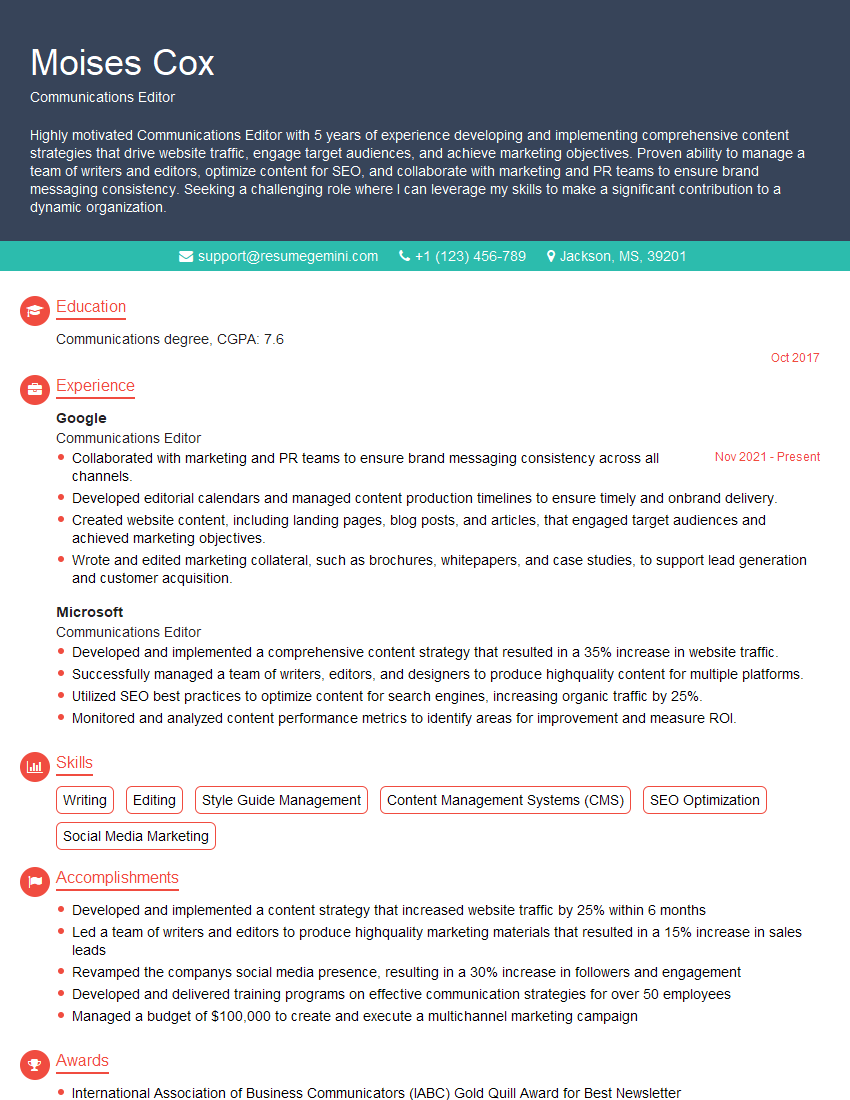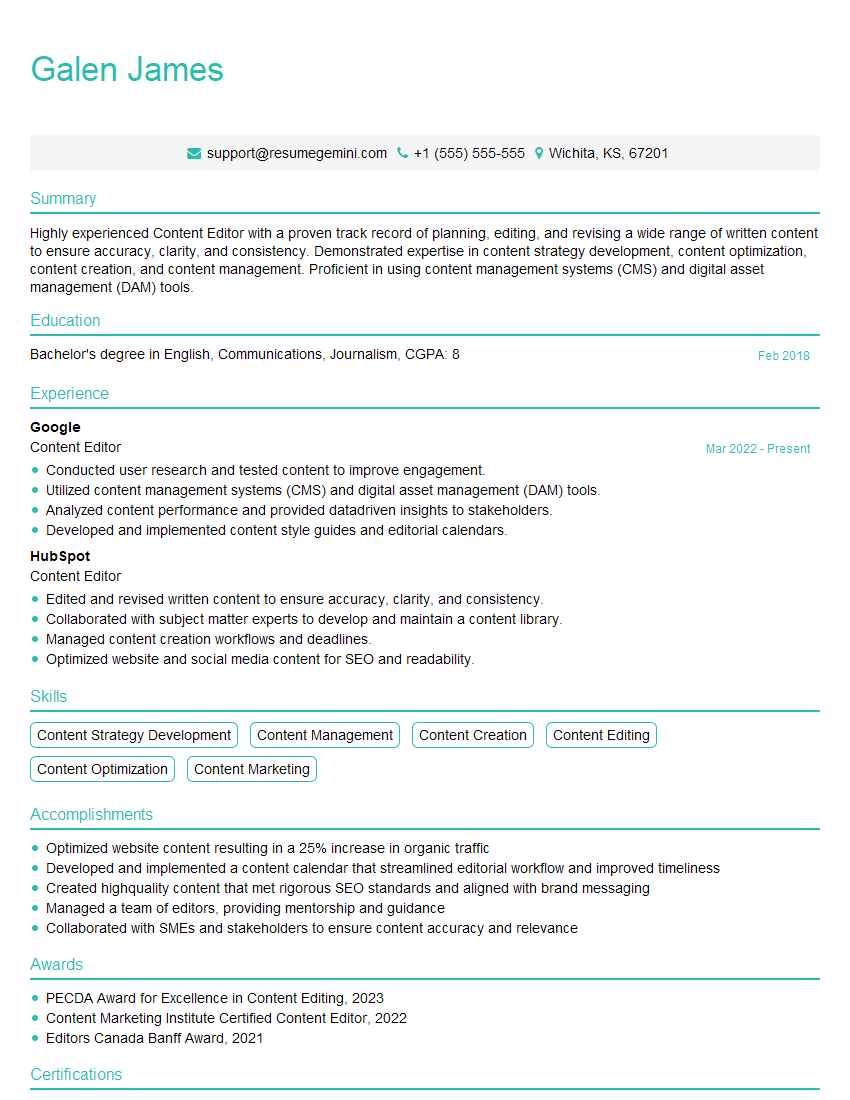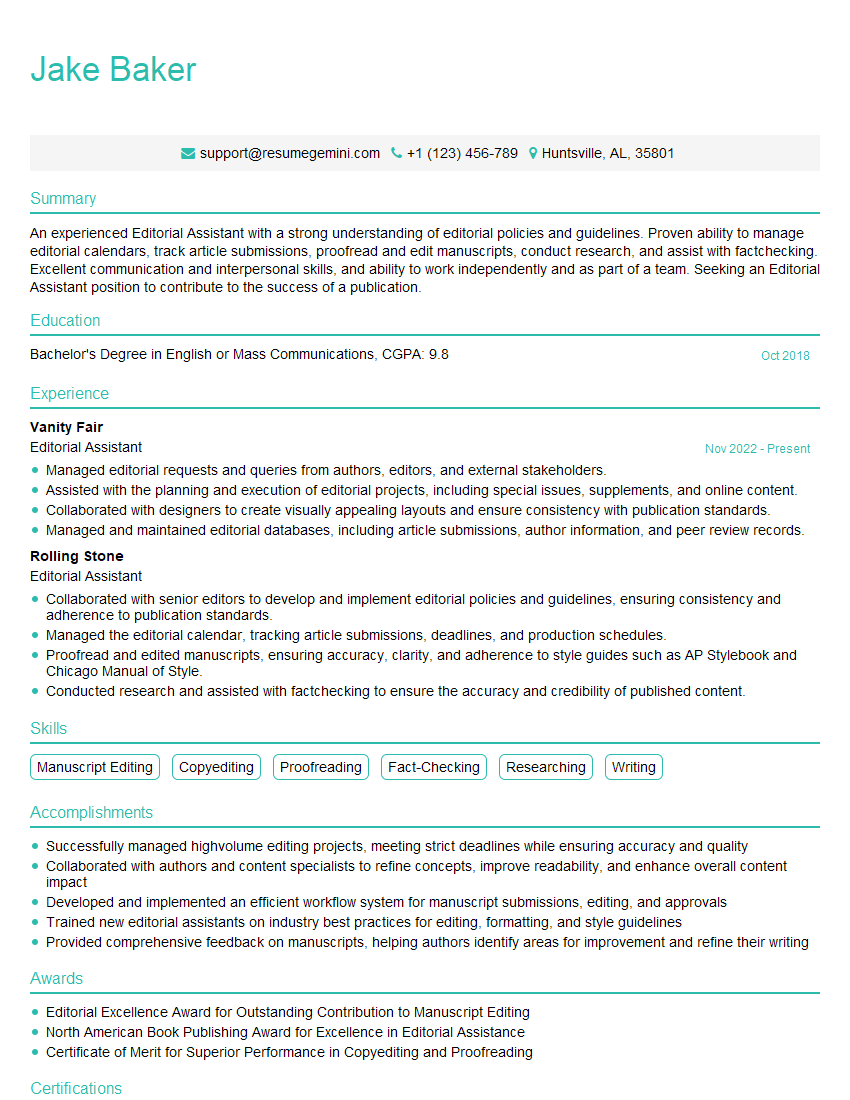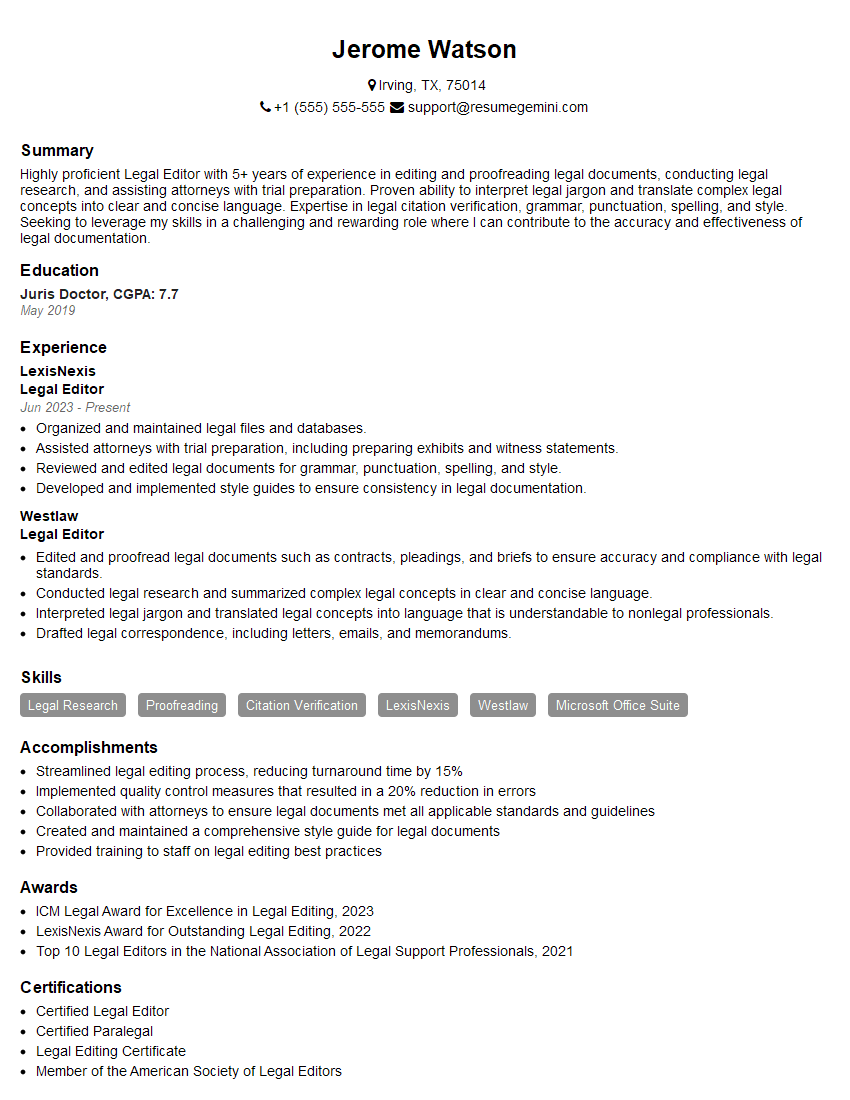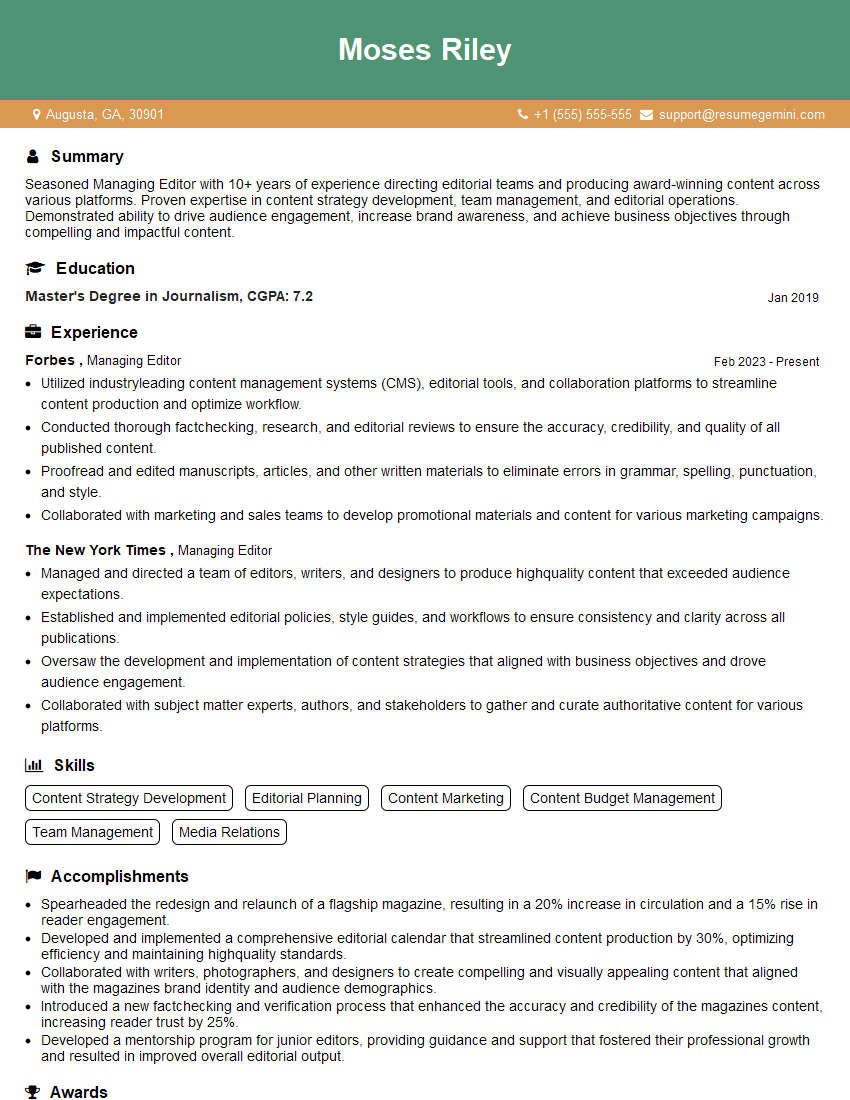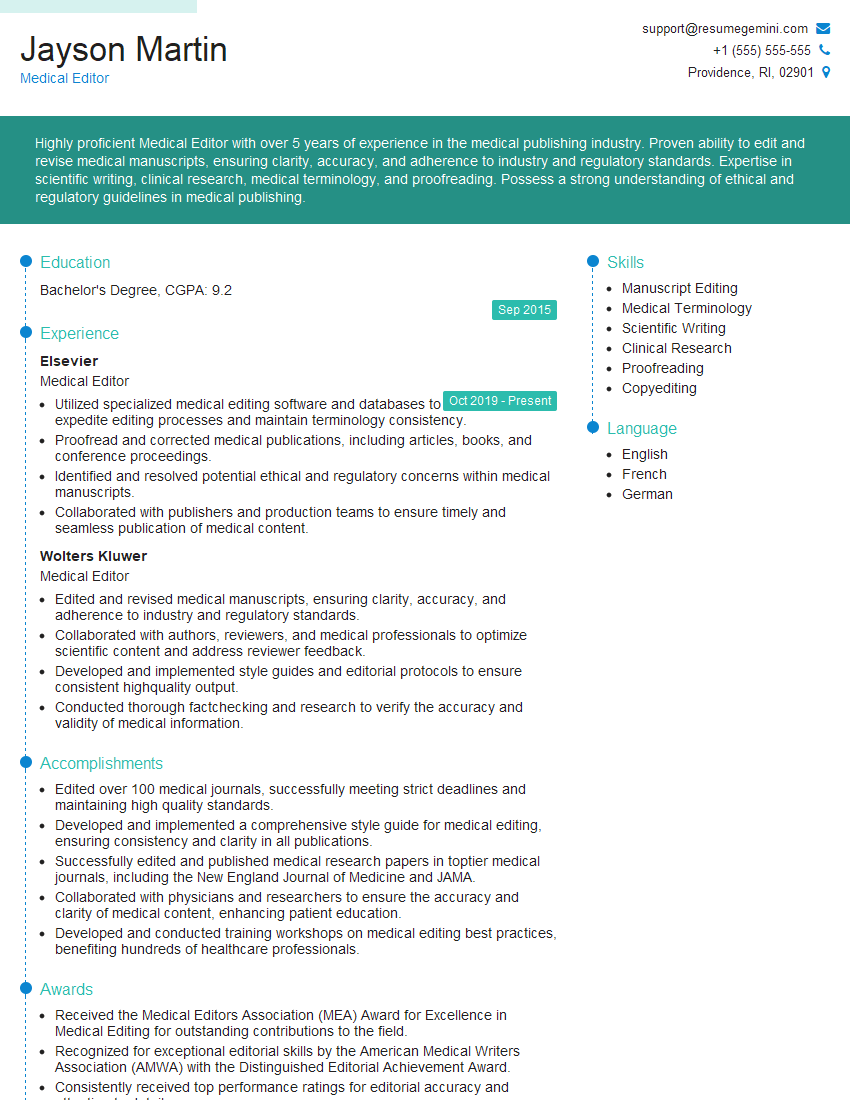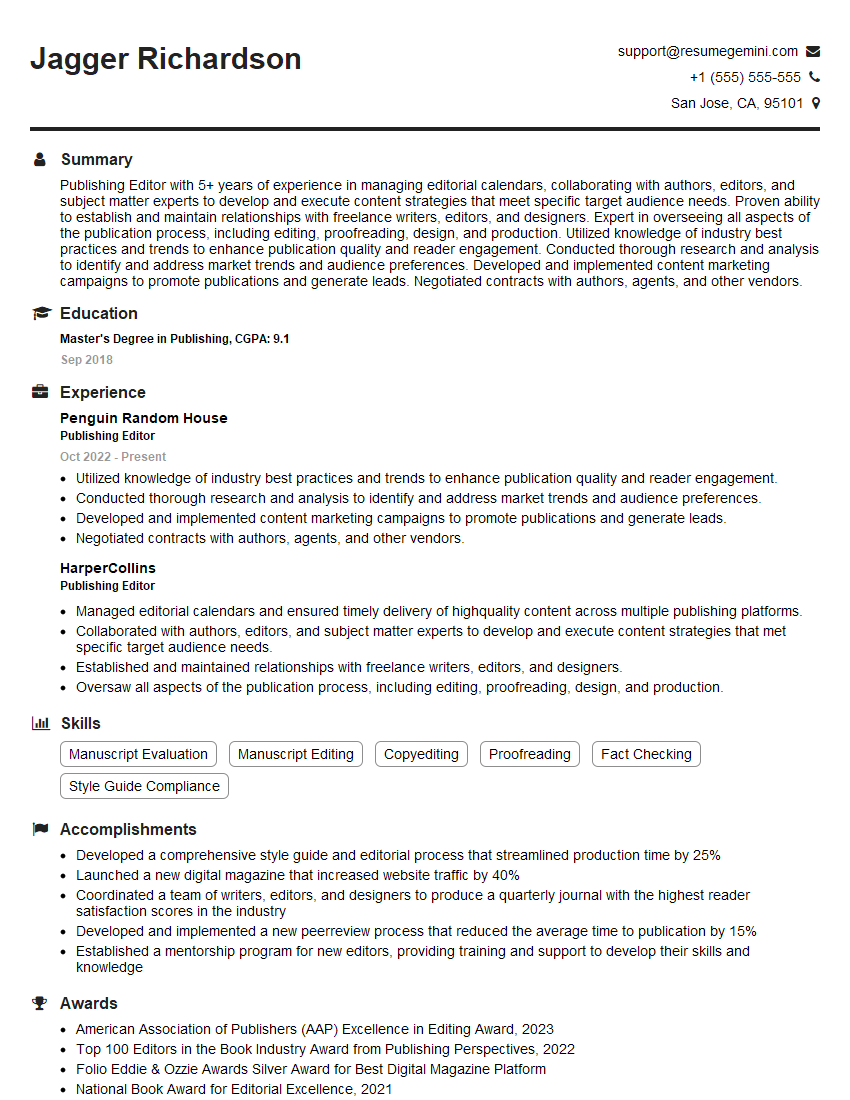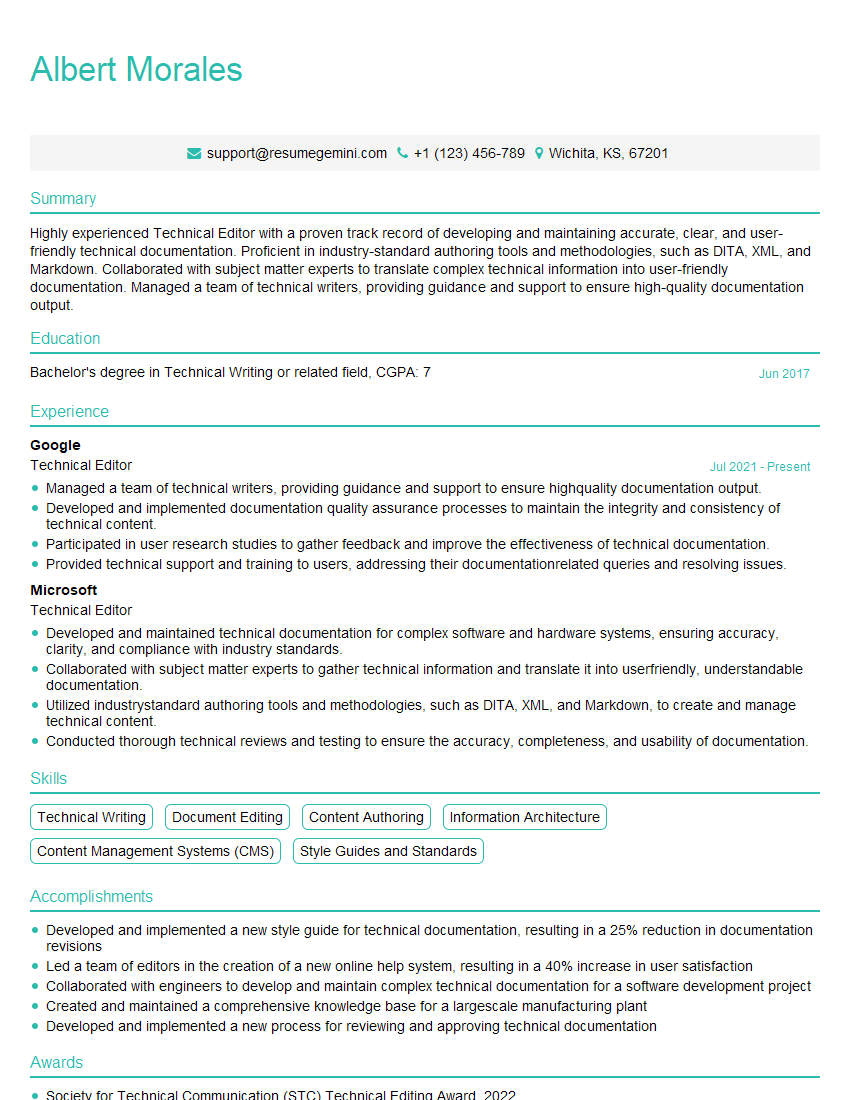Cracking a skill-specific interview, like one for Proofreading Tools Proficiency (e.g., Grammarly, ProWritingAid), requires understanding the nuances of the role. In this blog, we present the questions you’re most likely to encounter, along with insights into how to answer them effectively. Let’s ensure you’re ready to make a strong impression.
Questions Asked in Proofreading Tools Proficiency (e.g., Grammarly, ProWritingAid) Interview
Q 1. Explain the difference between Grammarly and ProWritingAid.
Grammarly and ProWritingAid are both excellent grammar and style checkers, but they cater to slightly different needs. Grammarly is known for its user-friendly interface and strong focus on grammar and punctuation correctness. It’s excellent for quickly catching typos, grammatical errors, and improving sentence structure. Think of it as a quick, reliable editor for everyday writing. ProWritingAid, on the other hand, offers a more in-depth analysis of writing style, including readability statistics, overuse of certain words, and sentence length variation. It’s more suitable for writers looking to polish their prose and achieve a consistent writing style. It’s like having a sophisticated writing coach providing detailed feedback.
In short, Grammarly excels at catching errors, while ProWritingAid helps refine style and clarity. Choosing between them depends on your priority: quick error correction or in-depth stylistic analysis.
Q 2. What are the limitations of automated proofreading tools?
Automated proofreading tools, while incredibly helpful, have inherent limitations. They struggle with nuanced aspects of language like context, irony, and subtle shades of meaning. For instance, they might flag a perfectly acceptable sentence as grammatically incorrect if it uses a slightly unusual construction but is perfectly clear in its context. Furthermore, these tools aren’t always perfect at distinguishing between different writing styles or dialects. What’s considered correct in academic writing might be flagged as an error in informal writing. Finally, they cannot assess the overall quality of your writing – its argumentation, logic, or originality – only surface-level grammatical and stylistic elements.
Think of them as helpful assistants, not replacements for a human proofreader. Always review the suggestions critically, using your judgment to decide which corrections are genuinely necessary.
Q 3. How do you use Grammarly’s plagiarism checker effectively?
Grammarly’s plagiarism checker is straightforward to use. Simply paste your text into the Grammarly editor, and it will scan the document against a vast database of academic papers, websites, and publications. It highlights any passages that are too similar to existing content, providing a percentage similarity score and indicating the source of the potential plagiarism. To use it effectively, understand that the tool is designed to identify significant overlaps, not minor coincidences of phrasing. If you’re using widely accepted information or common phrases, it’s less likely to flag them. However, ensure proper citation for all referenced material, even if not flagged.
Always review the flagged sections carefully, and if you’ve correctly cited your sources, you can usually dismiss them. Remember, the tool is a helpful aid, not a guarantee of originality. Human review remains crucial for plagiarism checks.
Q 4. Describe your experience with ProWritingAid’s style guide integration.
ProWritingAid’s style guide integration is a powerful feature for maintaining consistency in writing. You can choose from various predefined style guides, such as APA, MLA, and Chicago, or even create your own custom guide. Once selected, ProWritingAid automatically checks your document against that guide’s rules, highlighting deviations in formatting, citation style, and other aspects. This integration streamlines the editing process, ensuring your document adheres to the required style from the beginning.
I’ve found it incredibly helpful when working on academic papers or professional documents where adherence to a specific style guide is paramount. It significantly reduces the time spent manually checking formatting and citation details, letting me focus on the content itself.
Q 5. How would you handle a conflict between Grammarly’s suggestions and the style guide?
Conflicts between Grammarly’s suggestions and a style guide are common, especially with punctuation or formatting. My approach is to prioritize the style guide. The style guide represents the established conventions for the specific context (e.g., academic paper, company style guide). Grammarly’s suggestions, while often helpful, might not always align perfectly with these conventions.
For example, a style guide might prefer a specific punctuation style (e.g., Oxford comma), while Grammarly suggests omitting it. In such cases, I’d manually adjust the text to match the style guide, overriding Grammarly’s suggestion. I always note discrepancies in a separate document for future review and to maintain consistency across different pieces of writing.
Q 6. Which proofreading tool do you prefer for technical writing, and why?
For technical writing, I prefer ProWritingAid. While both tools handle grammar well, ProWritingAid’s focus on clarity and readability is particularly beneficial in technical contexts. Technical writing needs to be precise and unambiguous; ProWritingAid’s detailed reports on sentence length, passive voice, and readability scores help ensure that the document is easily understood by its intended audience. Its style guide integration is also invaluable for maintaining consistency in technical documentation, where standardized terminology and formatting are essential.
Grammarly is still a useful tool for a quick grammar check in technical writing, but ProWritingAid’s more comprehensive style and clarity analysis makes it my preferred choice for ensuring accuracy and readability in technical documents.
Q 7. How do you assess the accuracy of a proofreading tool’s suggestions?
Assessing the accuracy of a proofreading tool’s suggestions requires a combination of techniques. First, I always cross-reference the suggestions with established style guides and grammar rules. A suggestion that contradicts well-established linguistic principles should be treated with caution. Secondly, I test the tool’s suggestions in different contexts. If a tool consistently flags a particular phrasing as incorrect, but that phrasing is acceptable in a specific writing style or context, that might indicate a limitation of the tool. Finally, I use a combination of tools. Comparing suggestions across multiple tools can help identify inconsistencies or highlight areas where a particular tool might be unreliable.
Remember, no tool is perfect. Human judgment remains essential to ensure the quality and accuracy of any editing process.
Q 8. What are the key features of Grammarly that improve writing clarity?
Grammarly significantly enhances writing clarity through several key features. Its core strength lies in identifying and suggesting improvements to sentence structure, word choice, and overall conciseness. Think of it as a sophisticated editor offering personalized feedback.
- Conciseness suggestions: Grammarly flags phrases that can be simplified, eliminating unnecessary words and improving the flow. For example, it might suggest changing ‘due to the fact that’ to ‘because’.
- Sentence structure analysis: It detects complex or awkwardly structured sentences, suggesting ways to make them clearer and more impactful. Long, rambling sentences are flagged and broken down into shorter, more digestible units.
- Clarity-focused vocabulary suggestions: Grammarly goes beyond simple grammar checks; it suggests more precise and impactful word choices, helping to refine the overall meaning and prevent ambiguity. For instance, it might recommend ‘substantial’ instead of ‘big’ if the context calls for a more formal tone.
- Tone detector: This feature analyzes the overall tone of your writing, helping ensure it aligns with your intended audience and purpose. It’s especially useful for marketing materials or formal documents where tone is critical.
For instance, if I write ‘The reason why we are doing this is because we want to improve customer satisfaction,’ Grammarly would suggest simplifying it to ‘We’re improving customer satisfaction.’ This subtle change makes the sentence significantly clearer and more impactful.
Q 9. How can you effectively use ProWritingAid’s overused words report?
ProWritingAid’s overused words report is a powerful tool for refining writing style and making it more engaging. It identifies words and phrases you use excessively, potentially making your writing monotonous and less impactful. Think of it as a stylistic spring cleaning for your vocabulary.
Effective use involves a nuanced approach. It’s not simply about replacing every flagged word; context is crucial. Here’s a step-by-step approach:
- Review the report: Carefully examine ProWritingAid’s list of overused words. Note the frequency of each word and the context in which it appears.
- Analyze the context: Don’t automatically replace every instance. Ask yourself if the word truly needs replacing. Sometimes, repetition is acceptable for emphasis or clarity.
- Consider synonyms: If a replacement is needed, choose synonyms that maintain the original meaning and fit the overall tone of your writing. Use a thesaurus, but ensure the replacement isn’t just another cliché.
- Vary sentence structure: Overused words often stem from repetitive sentence structures. Varying sentence length and structure can naturally reduce reliance on particular words.
- Iterative refinement: Review your revised text to ensure the replacements improve flow and meaning. You might need several iterations to achieve the desired effect.
For example, if ‘very’ is flagged, instead of blindly replacing every instance with ‘extremely,’ consider alternatives that add more specific meaning, such as ‘incredibly,’ ‘exceptionally,’ or even rephrasing the sentence entirely.
Q 10. Describe a time you had to overcome a challenge using a proofreading tool.
I once faced a significant challenge using Grammarly while editing a complex legal document. The document was filled with highly specific jargon and technical terms that Grammarly, despite its extensive vocabulary, sometimes misidentified as errors. It flagged terms as incorrect simply because they weren’t part of its common usage database. This resulted in a conflict between the tool’s suggestions and the document’s necessary precision.
To overcome this, I employed a multi-pronged approach. First, I carefully reviewed each flagged instance, comparing Grammarly’s suggestion with the context within the legal document. If the term was correct, I added it to Grammarly’s custom dictionary, ensuring the tool learned to recognize it as valid within that specific context. This involved a detailed understanding of both the tool’s capabilities and the specific terminologies within the field of law. This meticulous approach was essential to guarantee the final document’s accuracy and adherence to legal language standards. The result was a thoroughly proofread and legally sound document while effectively managing Grammarly’s limitations.
Q 11. Explain how you would use Grammarly to proofread a marketing email.
Proofreading a marketing email with Grammarly requires a focused approach, leveraging its features to maximize impact and maintain brand consistency. Here’s my process:
- Set the tone: Before starting, I ensure Grammarly’s tone detector is set to match the intended tone of the email (e.g., friendly, professional, urgent). This ensures the suggestions are relevant.
- Comprehensive scan: I run a full Grammarly scan to identify grammatical errors, spelling mistakes, and punctuation issues. This forms the foundation of the editing process.
- Style and clarity review: I carefully analyze Grammarly’s suggestions related to clarity, conciseness, and word choice. I ensure the language is persuasive and engaging while remaining clear and concise. Marketing emails need to be effective and not just grammatically correct.
- Tone consistency check: I pay close attention to Grammarly’s tone analysis, ensuring the tone remains consistent throughout the email. Inconsistent tone can confuse or alienate the recipient.
- Call to action review: I ensure the call to action is clear, concise, and compelling. Grammarly might offer suggestions to improve the phrasing of the call to action.
- Final read-through: After making corrections, I conduct a final manual review to catch any nuances that Grammarly might have missed. A human eye often picks up subtleties that automated tools can’t.
This multi-stage process ensures the marketing email is not only error-free but also engaging, persuasive, and perfectly aligned with the brand’s voice.
Q 12. What are the ethical considerations when using AI-powered proofreading tools?
Ethical considerations when using AI-powered proofreading tools are paramount. These tools are powerful, but they are not perfect, and their use necessitates responsibility. Key concerns include:
- Bias detection and mitigation: AI models are trained on data, and this data can reflect existing societal biases. This can lead to biased suggestions, especially in areas like gender, race, and cultural references. It’s crucial to be aware of potential biases and to critically evaluate the tool’s suggestions, overriding them if necessary.
- Attribution and transparency: When using AI for significant writing tasks, it’s essential to be transparent about its role. Always acknowledge the AI’s contribution and ensure that the final product doesn’t misrepresent your own intellectual effort.
- Data privacy: Many tools require access to your writing. Ensure the tool provider has robust security measures and a clear privacy policy before using it, particularly for sensitive information.
- Over-reliance: AI tools should be used as aids, not replacements, for human judgment. Over-reliance can lead to lazy writing and a lack of critical thinking. Always edit and proofread carefully, even after the AI has run.
- Plagiarism detection: While these tools often have plagiarism detection features, it’s crucial to be proactive in avoiding plagiarism. Ensure you properly cite sources and avoid passing off someone else’s work as your own.
Using AI responsibly requires careful consideration and a commitment to maintaining ethical standards in writing.
Q 13. How do you manage the different style guides across various proofreading tools?
Managing different style guides across various proofreading tools requires a structured approach. Each tool might have its own settings or require manual adjustments to adhere to a specific style guide (like APA, MLA, Chicago). Consistency is key to avoid discrepancies.
My approach involves:
- Centralized Style Guide: Maintaining a master copy of the required style guide. This becomes the reference point for all tools.
- Tool-Specific Configurations: Configuring each proofreading tool (Grammarly, ProWritingAid, etc.) to the extent possible, utilizing their built-in style guide options. Many tools allow you to select pre-defined styles.
- Custom Dictionaries and Rules: For styles not fully supported, creating custom dictionaries and rules within each tool. This involves adding specific terminology or correcting inconsistencies identified by the tools.
- Manual Review and Adjustment: Despite configurations, manual review remains crucial. No tool is perfect. Checking for adherence to the style guide, especially for nuances not captured by automated settings, is vital.
- Regular Updates: Style guides evolve. Regularly updating both the master copy and tool configurations is essential to maintain accuracy.
This structured approach minimizes errors and ensures consistent style across all documents, regardless of the tool used.
Q 14. Explain the process of integrating a style guide into ProWritingAid.
Integrating a style guide into ProWritingAid isn’t as straightforward as with some other tools, but it’s achievable. ProWritingAid focuses more on general style and grammar, rather than specific style guide adherence like APA. The integration relies mostly on careful customization and manual review.
The process typically involves:
- Understanding ProWritingAid’s capabilities: ProWritingAid doesn’t directly import style guides. Its strength lies in its general style checks and its ability to highlight stylistic inconsistencies.
- Custom Style Settings: Use ProWritingAid’s existing settings to reflect as many aspects of your style guide as possible (e.g., punctuation, sentence structure preferences). This will improve consistency, but it might require iterative adjustments.
- Focus on Key Style Elements: Identify the most critical stylistic elements of your target style guide (e.g., citation format, heading styles). These are the areas where you’ll need the most manual review.
- Manual Review and Editing: ProWritingAid will highlight inconsistencies, but you’ll need to manually review and correct them based on your specific style guide. This requires meticulous attention to detail.
- Custom Dictionaries (if applicable): If your style guide uses specific terminology, consider adding these terms to ProWritingAid’s custom dictionary to prevent misidentification as errors.
Unlike tools with direct style guide import, ProWritingAid requires a more manual and iterative process. However, by focusing on key style elements and leveraging its existing features, you can significantly improve adherence to your desired style guide.
Q 15. How would you train a new employee on using Grammarly for consistent style?
Training a new employee on Grammarly for consistent style involves a multi-stage approach focusing on practical application and understanding its nuances. I’d start with a guided tour of the interface, highlighting key features like the style guide, tone detector, and plagiarism checker. We’d then move onto practical exercises. For example, I’d provide them with a sample document containing various stylistic inconsistencies – passive voice overuse, informal language in a formal context, etc. – and ask them to correct it using Grammarly. This hands-on approach allows for immediate feedback and reinforces learning.
Crucially, we’d discuss setting up a consistent style guide within Grammarly. This involves defining preferred choices for things like punctuation, capitalization, and number formatting. Consistency is key in professional writing, and Grammarly’s customizability allows us to enforce a specific style guide across all documents. Regular check-ins, review of their work, and open discussions about any challenges faced would ensure their proficiency and understanding of the tool. Think of it like learning a musical instrument – initial practice is crucial, followed by consistent application and refining the technique.
Career Expert Tips:
- Ace those interviews! Prepare effectively by reviewing the Top 50 Most Common Interview Questions on ResumeGemini.
- Navigate your job search with confidence! Explore a wide range of Career Tips on ResumeGemini. Learn about common challenges and recommendations to overcome them.
- Craft the perfect resume! Master the Art of Resume Writing with ResumeGemini’s guide. Showcase your unique qualifications and achievements effectively.
- Don’t miss out on holiday savings! Build your dream resume with ResumeGemini’s ATS optimized templates.
Q 16. What is your process for proofreading a document using both Grammarly and ProWritingAid?
My process for proofreading with Grammarly and ProWritingAid is a two-step, complementary approach. First, I use Grammarly for its comprehensive grammar and spelling checks, along with its suggestions for tone and clarity. Think of it as the first line of defense, catching the most common errors. I carefully review each suggestion, accepting or rejecting based on context and intended style. After Grammarly, I turn to ProWritingAid. It excels in identifying stylistic issues that Grammarly might miss, such as sentence length variation, overuse of adverbs, and weak verbs. ProWritingAid provides detailed readability statistics, helping me assess the overall flow and comprehension level of the document. It’s like having a second pair of eyes that focuses on the bigger picture of style and flow.
The combined use helps me catch a wider range of errors, ensuring the document is not just grammatically correct but also reads smoothly and engagingly. This is particularly important for longer documents or complex subjects where a second review is crucial for maintaining quality and consistency. For instance, I recently proofread a research paper; Grammarly caught basic grammatical mistakes, while ProWritingAid flagged the repetitive sentence structure, resulting in a more impactful and easier-to-understand final draft.
Q 17. How would you handle a situation where a proofreading tool misses a significant error?
Proofreading tools are invaluable, but they are not infallible. If a tool misses a significant error, my immediate response is to engage in a thorough manual review. I treat the tool’s output as a suggestion, not a definitive judgment. For instance, I would never rely solely on Grammarly or ProWritingAid to catch issues of factual accuracy or logical inconsistencies. These require human judgment and knowledge of the subject matter.
To mitigate future occurrences, I analyze *why* the error was missed. Was it a particularly complex grammatical structure? Was the error subtle or context-dependent? Understanding the tool’s limitations helps me to adjust my workflow and perform more focused manual checks in areas where the tool seems less effective. This could involve focusing more closely on specific sentence structures or using other resources such as a style guide or dictionary. It’s about learning from the mistakes, both the tool’s and my own.
Q 18. What are the advantages and disadvantages of using multiple proofreading tools?
Using multiple proofreading tools offers a significant advantage: a more comprehensive error detection. Different tools have different strengths. Grammarly excels at grammar and spelling, while ProWritingAid offers more in-depth stylistic analysis. Combined, they provide a more robust proofing process. However, using multiple tools also presents disadvantages.
- Redundancy: Both might flag the same issue, leading to wasted time.
- Conflicting Suggestions: They may offer different suggestions for the same sentence, requiring careful judgment.
- Cost: Using premium versions of several tools can be expensive.
The key is to strategically choose and utilize tools based on their strengths and to establish a workflow that minimizes redundancy and conflict. It’s a balance between thoroughness and efficiency. Think of it like having multiple specialists on a project – each brings expertise to the table, but their work needs to be coordinated effectively.
Q 19. How do you ensure accuracy and consistency while using proofreading tools?
Ensuring accuracy and consistency when using proofreading tools requires a combination of technical skills and critical thinking. First, I establish a consistent style guide, using Grammarly’s custom settings to enforce preferred choices for punctuation, capitalization, and other stylistic elements. This guide serves as a benchmark. I also carefully review each suggestion from the tools, rather than blindly accepting them all. Context matters – a suggestion that might be appropriate in one sentence might be wrong in another.
Regular calibration is essential. I compare the tools’ suggestions with established style guides and my own knowledge of grammar and style. Over time, I develop a sense of when to trust the tool’s advice and when to override it using my human judgment. Regularly reviewing and updating my style guide also helps ensure the consistency of my work.
Q 20. Describe your experience with Grammarly’s tone detector.
Grammarly’s tone detector is a powerful feature, particularly useful for ensuring that the tone of a document matches its intended purpose. It analyzes the word choices and sentence structures to identify the overall tone – formal, informal, assertive, persuasive, etc. This helps me fine-tune my writing to better connect with the intended audience. For example, a marketing email needs a different tone than a formal business report. The tone detector helps identify discrepancies.
However, it’s crucial to remember that the tone detector is a guide, not a definitive measure. The nuances of tone are complex and sometimes depend on context or cultural understanding. I always cross-check the detector’s suggestions with my own judgment to ensure accuracy and appropriateness.
Q 21. How do you leverage ProWritingAid’s readability statistics to improve a document?
ProWritingAid’s readability statistics are invaluable for improving the clarity and accessibility of a document. These statistics, such as the Flesch Reading Ease score and the Gunning Fog Index, provide objective measures of readability level. A high score indicates easier readability, while a low score signifies a more complex text.
By analyzing these statistics, I can identify passages that are too complex or dense. I can then use this information to simplify sentences, reduce jargon, and improve sentence structure for better comprehension. For example, if a section scores poorly on readability, I might break down long, complex sentences into shorter, more manageable units, replace complicated words with simpler alternatives, and ensure a logical flow of ideas. This iterative process, guided by ProWritingAid’s data, ensures my writing is clear, concise, and readily understood by my target audience.
Q 22. How would you address conflicting suggestions from different proofreading tools?
Conflicting suggestions from different proofreading tools are common. Think of it like getting advice from two different editors – they might have slightly different stylistic preferences. The key is to understand the why behind each suggestion. Don’t blindly accept or reject.
My approach is a three-step process:
- Analyze the context: Examine the sentence or phrase in question within the larger piece. Does one suggestion improve clarity and flow better than the other? Sometimes, one tool flags something technically correct but stylistically awkward, while the other misses the awkwardness but catches a minor grammatical error.
- Consider the tool’s strengths: Grammarly is excellent for grammar and spelling, while ProWritingAid excels at style and sentence structure. If Grammarly suggests a comma change and ProWritingAid doesn’t, that doesn’t necessarily mean Grammarly is wrong. However, if ProWritingAid identifies a problematic sentence structure that Grammarly misses, I’ll prioritize ProWritingAid’s suggestion.
- Make informed decisions: Ultimately, I’m the final arbiter. I weigh the suggestions, consider my target audience and the overall writing style, and make a judgment call. It’s about making the writing clear, concise, and impactful, not blindly following the advice of a machine.
For example, one tool might suggest changing ‘however’ to ‘but,’ while the other flags no issue. I would consider whether the change improves readability and maintains the intended tone. If ‘however’ sits within a more complex sentence, I might choose to keep it.
Q 23. What are some common mistakes that Grammarly often fails to identify?
Grammarly, while a powerful tool, isn’t perfect. It can miss subtleties of language and context. Some common pitfalls include:
- Nuances of tone and style: It might flag perfectly acceptable word choices based on its default settings, particularly informal language in a formal context or vice versa. For instance, it might flag perfectly acceptable contractions in a casual blog post.
- Complex sentence structures: While it catches many grammatical errors, it can sometimes struggle with unusually complex or nuanced sentences. If the sentence is grammatically correct but awkwardly phrased, Grammarly might miss this subtlety.
- Contextual errors: Grammarly lacks deep understanding of the context of the writing. It might flag perfectly appropriate word choices or phrasing if it lacks the context of the surrounding text. For instance, a correctly used colloquialism might be marked as incorrect if the surrounding text doesn’t clearly indicate informality.
- Idioms and figures of speech: Grammarly might incorrectly flag idioms or figures of speech because it treats them literally rather than interpreting their figurative meaning. For example, a sentence like ‘He’s got a chip on his shoulder’ could be flagged for incorrect use of the word ‘chip’.
Therefore, a human review after using Grammarly is crucial for catching these subtle errors.
Q 24. What are the best practices for using ProWritingAid’s sentence structure suggestions?
ProWritingAid’s sentence structure suggestions are invaluable for improving clarity and readability. However, blindly accepting every suggestion could lead to robotic and unnatural writing. Think of it as a guide, not a dictator.
Best practices include:
- Understand the suggestion: Before making any changes, thoroughly read ProWritingAid’s explanation for the suggested alteration. This explanation helps you understand the underlying issue and if the change truly improves the sentence.
- Consider context: Evaluate the suggestion within the surrounding text. A sentence that might be overly long or complex in isolation might be perfectly acceptable in context.
- Avoid overcorrection: ProWritingAid might flag stylistic choices that are perfectly acceptable or even preferable depending on the context. Don’t blindly change every suggested sentence; prioritize clarity and flow over strictly adhering to the suggestions.
- Experiment cautiously: If you’re unsure about a suggestion, try making the change and see how it affects the overall flow and readability. If it doesn’t improve the writing, revert the change.
- Prioritize readability and flow: Ultimately, the goal is to make your writing clear, engaging, and easy to understand. If a suggestion improves these aspects, then it’s worthwhile. If not, stick with the original.
For example, ProWritingAid might suggest breaking up a long sentence into shorter ones. If the long sentence is grammatically correct and easy to understand, I might retain it, especially if breaking it up disrupts the flow.
Q 25. How can you optimize the settings of Grammarly and ProWritingAid for different writing styles?
Both Grammarly and ProWritingAid allow for customization of their settings to suit various writing styles. This is crucial for tailoring the tools to your needs and avoiding unnecessary flags.
Optimizing settings involves:
- Choosing the right style guide: Select the style guide (e.g., APA, MLA, Chicago) relevant to your writing. This ensures the tools adhere to the appropriate conventions.
- Adjusting the sensitivity level: Both tools offer sensitivity settings that control how strictly they enforce rules. For informal writing, a lower sensitivity might be preferable to avoid unnecessary flags on contractions or colloquialisms. For formal writing, a higher sensitivity is usually better to catch potential errors.
- Customizing dictionary: Add words or phrases specific to your field or project to your custom dictionary. This helps prevent the tools from flagging perfectly acceptable terminology.
- Disabling irrelevant rules: If there are particular rules that don’t apply to your writing style, disable them. For example, if you’re writing fiction, you might disable rules related to passive voice or overly formal language. However, doing this requires careful consideration and a deep understanding of stylistic choices.
For example, when writing a creative piece, I’d lower the sensitivity and possibly disable rules related to passive voice and sentence length, as these stylistic choices are often intentional and contribute to the desired effect.
Q 26. Have you ever used Grammarly or ProWritingAid’s API for integration with other tools?
While I haven’t directly used the APIs of Grammarly or ProWritingAid for custom integrations, I’m familiar with their capabilities. I understand they offer APIs that allow developers to integrate their grammar and style checking functionalities into other applications. This could be incredibly valuable for building custom writing platforms or integrating proofreading capabilities into existing content management systems (CMS).
The potential applications are numerous: imagine a CMS that automatically checks blog posts for grammar and style errors before publication, or a custom writing app that provides real-time feedback. The API would facilitate this seamless integration, automating a tedious process. However, integrating these APIs requires considerable software development skills and an understanding of the API documentation.
Q 27. How would you explain the use of these tools to someone with limited technical skills?
Explaining these tools to someone with limited technical skills requires a simple analogy. I’d describe them as sophisticated spell checkers, but much more powerful.
I would say:
“Imagine you have a very smart assistant that helps you write better. These tools (Grammarly and ProWritingAid) check your writing for spelling and grammar mistakes, just like a regular spell checker, but they also look at sentence structure, style, and even tone. They suggest improvements to make your writing clearer and more engaging, much like a second pair of eyes reviewing your work, catching things you might have missed. Think of them as helpful guides to help you polish your writing before you share it.”
I would then demonstrate the tools using a simple example text, highlighting the suggestions and explaining the reasoning behind each recommendation in plain language, avoiding technical jargon.
Key Topics to Learn for Proofreading Tools Proficiency (e.g., Grammarly, ProWritingAid) Interview
- Understanding Core Features: Become proficient in navigating the interface and utilizing key features such as grammar and spelling checks, style guides, plagiarism detection, and tone detection.
- Practical Application: Practice proofreading various text types (e.g., emails, articles, reports) using the tools. Focus on identifying and correcting different types of errors (grammatical, stylistic, punctuation).
- Advanced Settings and Customization: Explore and understand how to customize settings to match different writing styles and requirements (e.g., adjusting tone detectors, selecting specific style guides).
- Interpreting Feedback: Learn to effectively interpret and apply the suggestions provided by the tools. Understand the nuances of different types of errors and how to best address them.
- Efficiency and Speed: Practice using the tools efficiently and quickly. Focus on streamlining your workflow to maximize productivity.
- Beyond Grammar and Spelling: Understand how these tools can enhance clarity, conciseness, and overall writing quality. Explore the advanced features related to style and tone improvement.
- Troubleshooting and Problem Solving: Prepare to address potential issues or limitations of the tools and how to handle conflicting suggestions.
- Comparison of Tools: If you have experience with multiple tools (Grammarly and ProWritingAid, for instance), be ready to discuss their strengths and weaknesses, and when you might choose one over the other.
Next Steps
Mastering proofreading tools like Grammarly and ProWritingAid is crucial for career advancement in writing, editing, and content creation roles. These skills demonstrate your commitment to accuracy, efficiency, and professionalism. To significantly boost your job prospects, create a compelling and ATS-friendly resume that highlights these skills. ResumeGemini is a trusted resource to help you build a professional and effective resume that showcases your abilities. Examples of resumes tailored to Proofreading Tools Proficiency (e.g., Grammarly, ProWritingAid) are available to help guide you.
Explore more articles
Users Rating of Our Blogs
Share Your Experience
We value your feedback! Please rate our content and share your thoughts (optional).
What Readers Say About Our Blog
Interesting Article, I liked the depth of knowledge you’ve shared.
Helpful, thanks for sharing.
Hi, I represent a social media marketing agency and liked your blog
Hi, I represent an SEO company that specialises in getting you AI citations and higher rankings on Google. I’d like to offer you a 100% free SEO audit for your website. Would you be interested?

